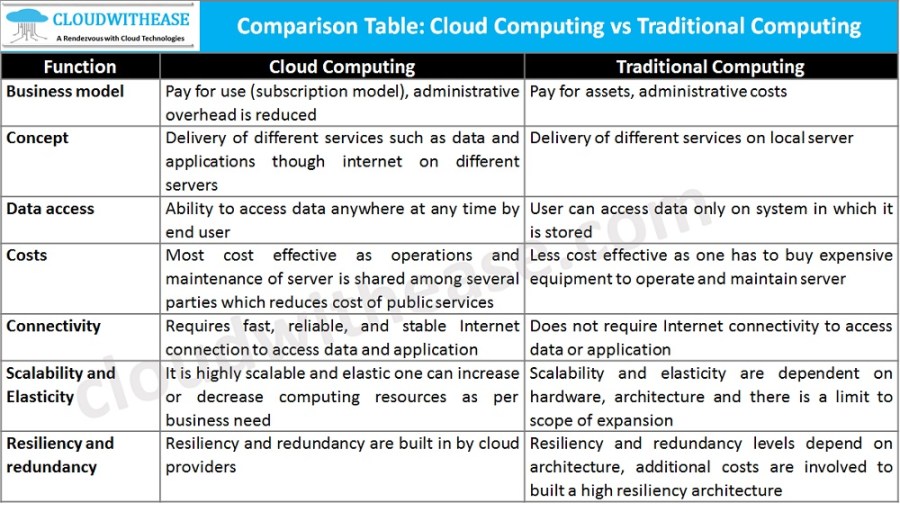Table of Contents
Traditional computing is all about physical servers, data centres, in-house staff to support daily operations whereas cloud computing is all about outsourcing computing functions to cloud providers and getting rid of hardware management, software management also at times.
Enterprises are moving from traditional computing models to cloud based computing in the past few years due to ease of management, lowering costs, scalability, resiliency, and many other benefits which cloud brings with it.
In today’s article we will discuss in detail about cloud computing vs traditional computing, what are the limitations of traditional computing and why enterprises are moving onto cloud services model, advantages and use cases.
What is Cloud Computing?
Concept of cloud evolved in 1950 (IBM) called RJE (Remote job entry process). In 2006 Amazon provided the first public cloud AWS (Amazon web service).
Cloud computing is a combination of configurable system resources and services that can be delivered using the internet. It provides lower power expenses, no capital costs, lower skill employee costs, improved collaboration and scalability. It makes things more efficient, less cumbersome.
Cloud computing architecture is a combination of service-oriented architecture and event driven architecture and it is divided into two parts Front end and Back end.

- Front end is used by the end user and it contains client-side interfaces and applications that are required to access cloud computing platforms. The front end comprises web servers including Chrome, Firefox, Internet explorer browsers etc., thin clients, tablets and mobile devices.
- The back end is used by service providers to manage all resources required to provide cloud computing services including data stores, security components, virtual machines, servers, traffic management mechanisms etc.
What is Traditional Computing?
In traditional computing physical data centres are hosted to store digital assets and run networked systems for daily operations. Access to data, software or storage by end users is limited to devices or office networks connected within. Server is installed onsite and provides services to the one who has access to hardware with an overview of stored data and applications.
Businesses often spend too much to maintain their data centers up to date and free of known vulnerabilities, as these data centers are lacking in a variety of ways when compared to cloud computing technology.
Despite all the dismay that traditional computing firms bring in terms of money and expenses, there is one favourable aspect of them. These data centres are regarded as the most secure platforms for controlling data modification, addition, and deletion according to business commands. Cloud computing systems are not so flexible in this regard.

Comparison Table: Cloud Computing vs Traditional Computing
Below table summarizes the points of differences between the two types of computing:

Strengths and Weaknesses: Cloud Computing
- No physical hardware, Updation or installation cloud handles everything remotely ensuring flexibility.
- Customization of software as per requirement and implement changes immediately.
- Accessing data from any devices virtually from anywhere.
- Real time collaboration.
- But downside is what about the security when anywhere data can be accessed virtually? Cyber risks have increased multifold post cloud explosion.
- Loss of control because service provider owns, manages, and monitors the cloud infrastructure.
Final Words
There are many advantages of moving to the cloud, and you will certainly see a return on your investment. It is a long-term strategy with significant advantages beyond cost. The business’s survival depends on its ability to adapt to the new changes, and that is why cloud computing is the future. Don’t dawdle and get ready to move to the cloud.

